Call | Text | WhatsApp

Are Underwater Scooters Safe?
Generally speaking, yes, underwater scooters are safe. However, there are some additional considerations to keep in mind before using one. We recommend sticking around as we dive into specific safety concerns to take into consideration, some underwater scooter safety features, and more.
Table of Contents - Are Underwater Scooters Safe?
Read ahead by tapping one of the questions below.
- What is an Underwater Scooter?
- How do Underwater Scooters Work?
- How Safe Are Underwater Scooters?
- What Are the Risks Associated with Using Underwater Scooters?
- What Are Some Underwater Scooter Safety Features?
- What Are Some Underwater Scooter Safety Tips?
- Are Underwater Scooters Safe for Beginners?
- Are Underwater Scooters Safe for Kids?
- Are Sea Scooters Safe?
- Are Diver Propulsion Vehicles Safe?
What is an Underwater Scooter?
Underwater scooters, also known diver propulsion vehicles (DPV), sea scooters, or water scooters are a type of equipment or device that help users get around underwater with almost no physical effort.
Want to learn more about underwater scooter basics? Check out our guide, What is an Underwater Scooter?
What underwater scooter should I get? We recommend checking out our detailed buyer's guide, What Underwater Scooter Should I Buy? or tap the button below to take our quick 3-question quiz to get recommendations right now!
How Do Underwater Scooters Work?
Underwater scooters work by the use of a combination of an electric motor and propeller to produce thrust. This thrust propels the user through the water with little to no effort.
By doing so, users exert less energy, extend dive times, explore further, and are able to focus on the experience had.
How Safe Are Underwater Scooters?
We started this safety guide by saying that underwater scooters themselves are safe, but safety can be subjective to some extent. There are some risks, safety guidelines, and other particulars that should be taken into account before using one.
Like any recreational or technical equipment used in the water, underwater scooters can be safe when used properly and responsibly. This largely depends on various factors such as the user's swimming ability, familiarity of their scooter and other equipment used in tandem, willingness to adhere to manufacturer safety guidelines, and other various external factors such as the environment it is used in.
What Are the Risks Associated with Underwater Scooters?

Underwater scooters have built-in safety features and users may be up to speed with their abilities in the water, but there are still factors to consider before using one.
Scuba divers may face many more risks than someone behind an underwater scooter in a pool, but these risks apply to all users regardless of use.
Let's dive into six potential risks and how you can mitigate them to remain safe when operating your underwater scooter.
1. Loss of Control
Some underwater scooters are more powerful than others with higher pounds-force, a measure of thrust. Inexperienced, younger, or smaller users may struggle to maintain control, with the potential of losing control altogether. This is especially more likely to occur in stronger currents.
Loss of control can lead to collisions, injuries, or becoming stranded.
How can I mitigate the risk of loss of control of my underwater scooter? Being familiar with your underwater scooter and accompanying equipment, understanding personal experience and training limitations, and being aware of the dive conditions prior to getting in can help minimize this risk.
2. Accidental Collision

Visibility plays a huge role in how users navigate underwater. Sometimes visibility is low or if users are not paying attention, they may inadvertently come into contact with or collide with underwater obstacles such as rocks, coral reefs, marine life, other divers, or even the side wall of a pool.
Collisions can result in injury or damage to the user, others in the water, equipment, or environment.
How can I mitigate the risk of accidental collision with my underwater scooter? Mitigating the risk of collision requires user awareness, a good pre-dive checklist and dive plan, and familiarity of the scooter's features and operation mechanisms.
3. Propeller Entanglement

The propeller and any other potential moving parts of an underwater scooter pose a risk of entanglement. This is especially common in underwater environments dense with vegetation or debris. Additional entanglement risks can include the user's limbs, clothing, or other diving equipment.
Underwater scooter propeller entanglement can result in injury to the user, others, marine life, and damage or failure of equipment.
How can I mitigate the risk of propeller entanglement with my underwater scooter? This can be avoided by user awareness of propellers in relation to self, others, marine life, equipment, and environment. In environments where debris is denser, can revert to traditional finning.
4. Underwater Scooter Limitations
Underwater scooters vary in capabilities, specifically what depths they are rated for, what temperatures they can safely operate in, and how long batteries will run under different conditions.
Improper use of underwater scooters beyond the scope of their limitations can lead to injury or death of self and others, catastrophic failure of equipment, or becoming stranded in the water.
How can I mitigate the risk of underwater scooter limitations? It is essential to understand the limitations of your underwater scooter prior to use, monitor dive tables or use a dive computer ensure you are within scooter depth limitations, and conduct sufficient pre-dive planning to account for battery runtimes.
5. Underwater Scooter Malfunctions or Failure
Like any electronic device, underwater scooter batteries can malfunction, overheat, or experience power loss unexpectedly. Mechanical failures or defects in the underwater scooter's components, such as the motor, propeller, or housing, can also occur unexpectedly.
Underwater scooter malfunctions or failure can lead to various unintended outcomes such as becoming stranded, injury, and more.
How can I best mitigate the possibility of underwater scooter malfunctions and failure? Underwater scooters are like any other piece of equipment. All of their components require initial testing, pre- and post-use inspections and preventative maintenance, and periodical maintenance to ensure they are operating as designed. Familiarizing yourself with your equipment and required maintenance, not operating a questionable unit, and not diving beyond your own limitations or skills are all ways to best address this risk.
6. Underwater Scooter Diving Hazards

Diving without underwater scooters already comes with risk. These risks don't change but require more diver awareness when using an underwater scooter. Individuals not accustomed to physical activity or long dives may also experience overexertion.
Using underwater scooters for diving purposes may increase the risk of medical implications such as decompression sickness (DCS) if users exceed safe ascent rates or depth limits which can lead to various injuries and even death.
How can I mitigate the risk of various diving hazards when using an underwater scooter? Standard dive protocols and safety guidelines required for certification are the basis of safe diving. Additional ways to mitigate this risk are to attend a diver propulsion vehicle (DPV) course at your local dive shop, ensure you are familiar and confident with your underwater scooter, and maintain dive insurance.
Click or tap the banner below to explore dive and travel insurance options today.
What Are Some Underwater Scooter Safety Features?
One of the common themes associated with underwater scooter risk mitigation and safety is training and understanding the scooter itself. Every model has its specific features and operation procedures. Being in tune with your equipment and its functions is paramount.
Safety is at the top of the list when manufacturers design and develop underwater scooters. From specific features to safety guidelines, manufacturers go through the proper procedures to make certain these are present for users to safely use their underwater scooters while minimizing any risks or hazards involved.
Let's dig into seven common underwater scooter safety measures and what they provide.
1. Safe Start Mode
Safe starting underwater scooters are those that start up in a slow or gradual manner upon activation. This feature ensures there is nothing obstructing the propeller and also prevents jerking the user in a quick or unsafe manner.
2. Propeller Cages or Guards
Propellers are generally the only exposed component of an underwater scooter. Some props are more exposed than others.
This largely depends on the application the underwater scooter was designed for and who the anticipated user is.
To avoid propeller entanglement or obstruction, most models have caged in propellers or some other form of propeller guard.
3. Trigger Locks and Sequences
To prevent accidental or child activation, most underwater scooters have either a trigger lock, a trigger sequence for activating the scooter, or both.
These go hand-in-hand with unwanted activation and are excellent features to look for to ensure the little ones don't take the underwater scooter for a joyride.
Trigger locks are generally a physical switch that block activation of the trigger.
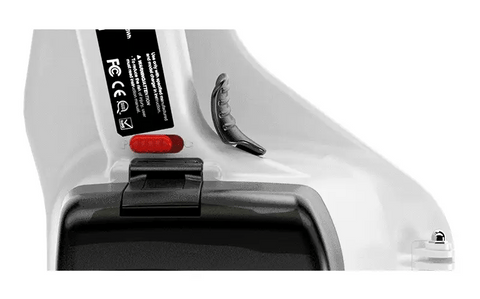
Trigger sequences can best be described as a double tap of the triggers for activation, requiring all triggers to be activated, or other model specific actions.
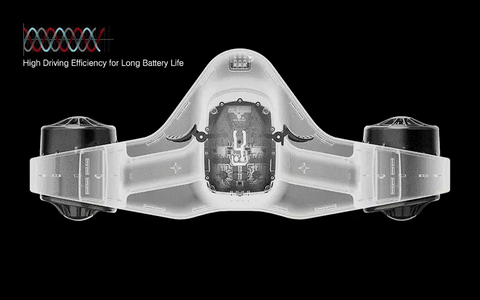
4. Auto-Shutoff
Underwater scooters with an auto-shutoff feature can prevent user injury or equipment failure. Most models have one or both of the following specific auto-shutoff mechanisms.
Auto-shutoff from water intrusion or flooding of the battery compartment is a feature that shuts down the underwater scooter when the battery comes into contact with water.
Auto-shutoff from propeller intrusion of foreign debris is when the underwater scooter shuts down due to propeller obstructions.
5. Built-In Buoyancy
Built-in buoyancy is when underwater scooters are manufactured to float naturally and on their own. This helps users regulate depth and efficiently control their scooter. Younger ones also benefit at remaining near the surface or have a much easier time resurfacing.
An additional safety consideration with this is loss of equipment. Underwater scooters that are not buoyant will sink if let go. To prevent loss, most models come with an underwater scooter leash or tow cord.
6. Smart Device Applications
Underwater scooters are now being developed alongside smart devices allowing users to control, modify, and customize their underwater scooters with apps.
Some common features seen on apps are child safety locks, speed control, safety notifications, battery life, depth limits, and even errors.
7. Screen Displays and Notifications
Not all underwater scooters may be app-friendly, but there are some with LED displays or other user-notifying features. These allow users to be more aware of the status of their scooter.
LED displays provide a great way of keeping users informed of battery level, speed, depth, temperature, errors, and more.
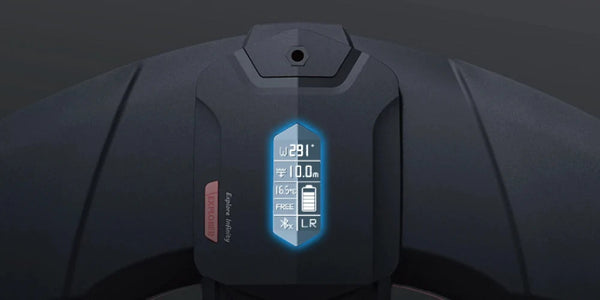
Sound or vibration notifications are now providing users feedback in ways similar to cell phones. Some underwater scooters emit these notifications when battery is running low, depth limitations are nearing, or other errors are occurring.
These features give users the opportunity to correct their course as needed to avoid unnecessary risks.
What Are Some Underwater Scooter Safety Tips?
We have gone over ways to mitigate specific risks, but below are some additional tips to consider.
By following these seven guidelines and using common sense, you can enjoy using underwater scooters safely and responsibly. Always prioritize your safety and the safety of others when engaging in any water-based activities.
1. Safety Gear
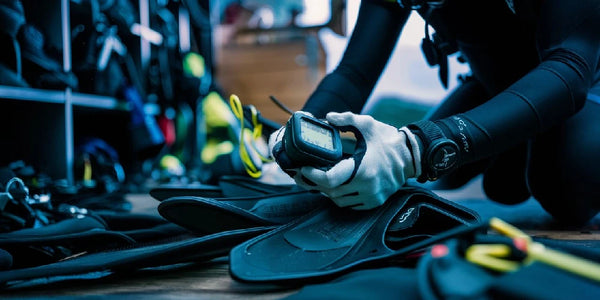
Acquiring the proper safety equipment or gear for the application of your underwater scooter is critical.
Always wear appropriate safety gear such as a life jacket, snorkel, dive mask, fins, wetsuits, buoyancy control devices, harnesses, or helmets in overhead dive environments when using underwater scooters. Verifying these items are in good working condition prior to use is also just as important.
If you're not diving from a charter, consider using a dive flag to make your presence known to other watercraft.
Carry essential emergency equipment such as a signaling device, whistle, and first aid kit. Familiarize yourself with emergency procedures and be prepared to respond calmly and effectively in case of emergencies.
2. Training and Familiarity
Ensure you get properly trained in using the underwater scooter before taking it to the water. Most local dive shops offer these courses to further build confidence and experience.
An example of a local dive shop that offers this course and many others is Islands Tec Dive. Check out their list of Advanced and Specialty Diving Courses for some examples of continued dive education options.
Looking for global underwater scooter or DPV certification courses? Check out some of these through the global diving certification agencies below.
- PADI | Continuing Education - Diver Propulsion Vehicle Course
- SSI | Become a certified Scooter/DPV Diver
- SDI | Diver Propulsion Vehicle Diver Course
Familiarize yourself with your underwater scooter by reading the manual prior to first use. Inspect it thoroughly and take the time to understand how to operate and maneuver it safely.
3. Preventative Maintenance
Before each use and periodically, inspecting the underwater scooter for any signs of damage or malfunction is a preventative way to mitigate risk. Ensure that all components, including seals and battery compartments, are intact and functioning correctly.
If your underwater scooter manual calls for routine maintenance or cleanings, performing it will ensure for a long-lasting unit.
4. Follow Depth and Dive Times
Pay attention to depth and dive time limits recommended for the specific model of the underwater scooter. Exceeding these limits could lead to dangerous situations such as decompression sickness.
5. Don't Stop Swimming
Underwater scooters take most of the physical effort out of the experience, but it is essential to still practice your swimming ability. In case of any unforeseen circumstances, being able to swim to the surface safely is crucial.
6. Bring a Dive Buddy
Always use underwater scooters in the presence of a buddy, trained professional, or guardian.
Depending on the user's age and experience, always follow manufacturer safety protocols regarding this.
Using underwater scooters in the presence of others allows for mutual assistance in the case of emergencies.
7. Environmental Conditions
Be mindful of weather conditions and water currents before using underwater scooters.
Avoid strong currents, rough seas, or adverse weather conditions that could compromise safety.
Consider the dive location's geography for safer navigation.
Know where nearby facilities are located and the numbers to reach emergency services.
Exercise caution and respect marine life while using underwater scooters. Avoid disturbing or touching marine organisms and maintain a safe distance from fragile coral reefs.
Are Underwater Scooters Safe for Beginners?
Yes, underwater scooters can be safe for beginners. Everyone starts as a beginner and taking the appropriate steps to seek out underwater scooter education and training, in addition to recognizing your own limitations, is an effective approach for new users.
Investing time in education and training is invaluable. Many diving communities offer safety courses specifically tailored to diver propulsion vehicles (DPVs), covering essential topics such as proper handling techniques, emergency procedures, and dive planning considerations. Participating in such courses not only enhances safety awareness but also fosters a deeper understanding of underwater navigation and conservation principles.
Aside from investing time in education and training, it's worth noting that certain underwater scooters, particularly those at the higher end of the market, are engineered with features catering to experienced divers who frequently venture into deeper waters. For beginners, starting with a more affordable model designed for shallower dives can provide a safer learning environment until one becomes more proficient in handling underwater scooters.
Are you a newcomer to the world of underwater scooters? Check out our selection of the best underwater scooters for beginners.
Are Underwater Scooters Safe for Kids?
Yes, underwater scooters can be safe for kids. Safety is paramount when considering underwater scooters for children. While these devices can offer an exciting opportunity for youngsters to experience the thrill of underwater scooters, it's essential to take appropriate and responsible precautions to ensure their well-being.
Parents should carefully evaluate the age, size, and swimming ability of their child before allowing them to use an underwater scooter. Younger children or those with limited swimming skills may not have the coordination or strength necessary to control the scooter safely.
Supervision and where the underwater scooter is used is also important. Adults should closely monitor children while they're using an underwater scooter and follow manufacturer guidelines on safe environments. Additionally, providing proper instruction and guidance on safety practices. Lastly, investing in quality safety gear will further enhance the safety of the experience for kids.
Selecting the right size and type of scooter is crucial. Some models are specifically designed with features such as reduced speed or simplified controls to accommodate younger users. Starting with a smaller, more manageable scooter can help children gain confidence and experience gradually.
Need help picking one out for your child? Check out our selection of the best underwater scooters for kids.
Are Sea Scooters Safe?
Yes, sea scooters are safe. A sea scooter is just another term for underwater scooter. Following the aforementioned safety guidelines and considerations, sea scooters can provide an enjoyable and exhilarating underwater experience for users of all ages.
Remember to prioritize proper training, familiarization, supervision, and equipment selection to ensure a safe and memorable experiences.
Are Diver Propulsion Vehicles Safe?
Yes, diver propulsion vehicles are safe. Like a sea scooter, a diver propulsion vehicle is also another term used for an underwater scooter. They are generally referred to as higher-end models for more experienced users, but all of the same guidelines apply for safe and enjoyable diving experiences.
Final Underwater Scooter Safety Thoughts
While underwater scooters can be safe and offer an exhilarating means of exploring the underwater world, safety should always remain a top priority.
By adhering to recommended safety guidelines, acquiring proper training, and selecting appropriate equipment, users can mitigate risks and enjoy underwater adventures responsibly.
Whether you're a seasoned diver or a newcomer to the underwater realm, prioritizing safety ensures a memorable and secure dive experience with underwater scooters. So, dive in, explore, and enjoy the wonders beneath the waves while staying safe and responsible!
Do you have additional thoughts to add on underwater scooter safety? Comment below!



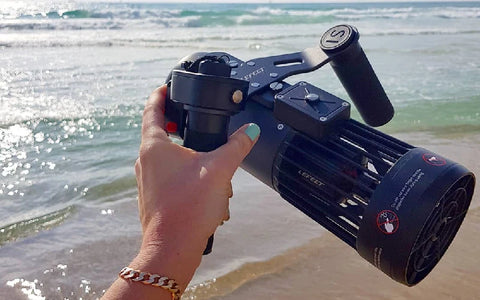
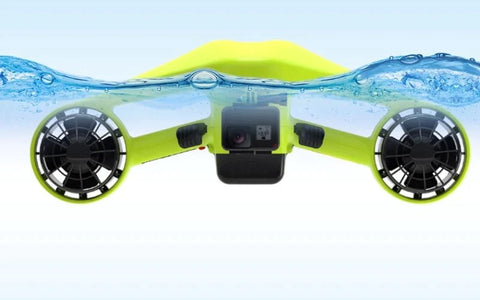
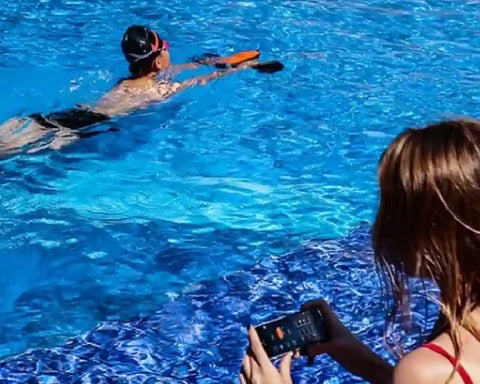
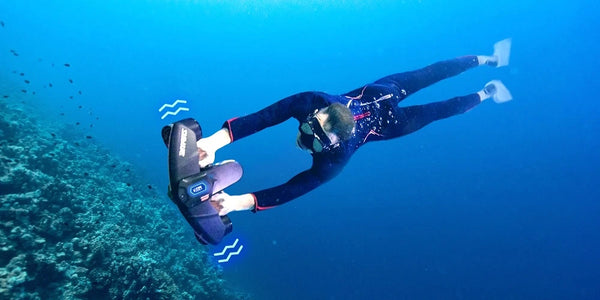
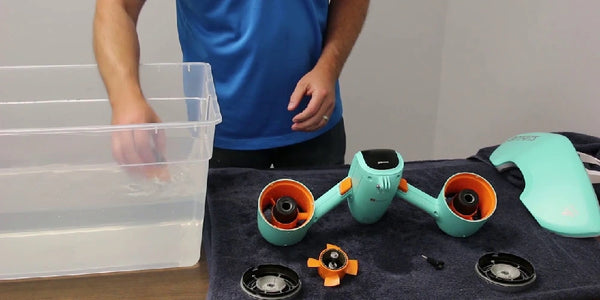

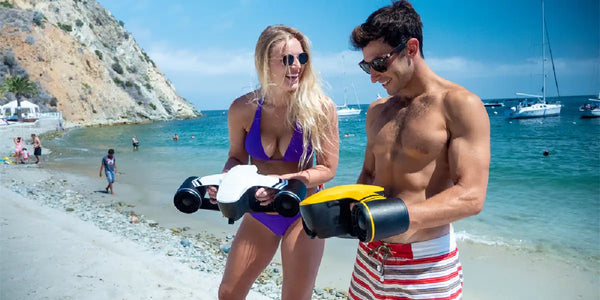
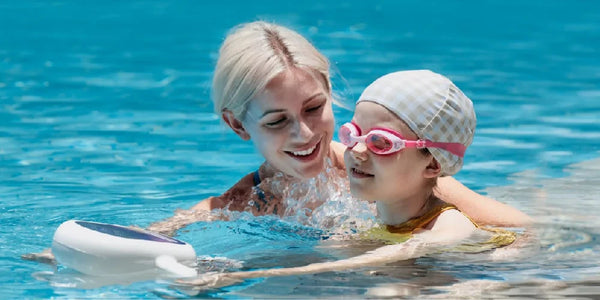

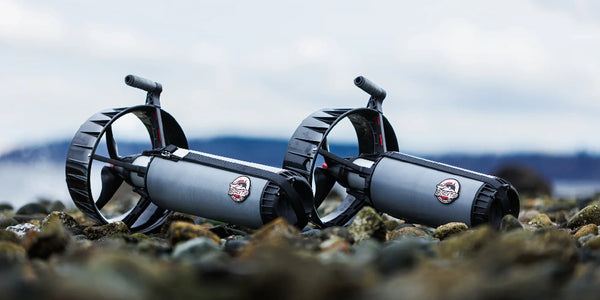
Comments
Leave a comment